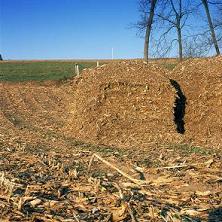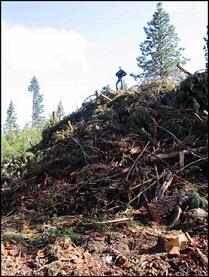What is Biomass?
Biomass is biological material that is either alive or recently dead. Biomass is typically burned:
Biomass such as timber, corn, and fish are grown because they're marketable. After the marketable portions are extracted, these biologically-derived materials become slash, corn cobs, and offal, commodities which are described as having a negative market value ‒ a fancy way of saying that it costs money to dispose of them in ways that don't harm the environment. Currently, a significant fraction of the world's arable land is being used to produce biomass such as corn and soybeans. These products are then used to create fuels such as bio-ethanol and bio-diesel. A prime motive for the B2M Project is the belief that the production of food to be used as fuel is just plain wrong. Accordingly, this project is focused on the many sources of biomass with a negative market value, biomass which is generally classified as waste. Instead of having to pay to truck them to the landfill, a community can use these resources to make their own fuel ‒ an alchemy which transforms a liability into an asset that meets local energy needs, creates local jobs, and preserves the local environment. Given the state of the world today, that's a goal worthy of our best efforts. Waste BiomassModern communities use a lot of petroleum based fuels; is it reasonable to think that any biologically based process can provide a significant fraction of that fuel? Is there enough waste biomass being generated to justify building community scale conversion plants? We can start to answer that question by taking a look at some of the sources of waste biomass that a community can use to make their own liquid fuel.
Agricultural WasteCorn stover, left over from harvesting corn, is an example of agricultural waste with little value. In Arkansas, for example, 984,000 dry tons of corn stover are produced each year. This is one example of an agricultural waste that could be used as a feedstock for the production of liquid fuels.
Logging WasteHere in Klickitat County, Washington, logging practices produce about 15,000 tons of waste, called "slash," every year. Slash piles have to be disposed of in the interest of preventing forest fires, and it costs about $800 dollars an acre to pile the logging waste up, cover it with plastic to keep it dry, and then return to burn it in the rainy season. Locally, the Department of Environmental Quality issues air quality warnings every winter because of this practice.When a slash pile is burned, the large pile of brush is transformed into a concentrated pile of caustic ash sitting on top of heat sterilized ground. These "hot spots" are too minerally dense and remain barren for years.
Trees Killed by Invasive SpeciesInvasive species eradication efforts generate tons of unwanted biomass each year in the US.On the left is a picture of the damage done by the pine beetle as it heads south where it is not native. Because of the increased number of dead trees, a forest fire in this area will be amplified and can overwhelm the forest beyond its ability to recover. Removal of these dead trees will both protect the remaining forest and provide feedstock for liquid fuel production. Portable methanol processors can be set up on-site in these remote regions thereby sidestepping the challenges inherent in loading, transporting, and unloading solid biomass. |


